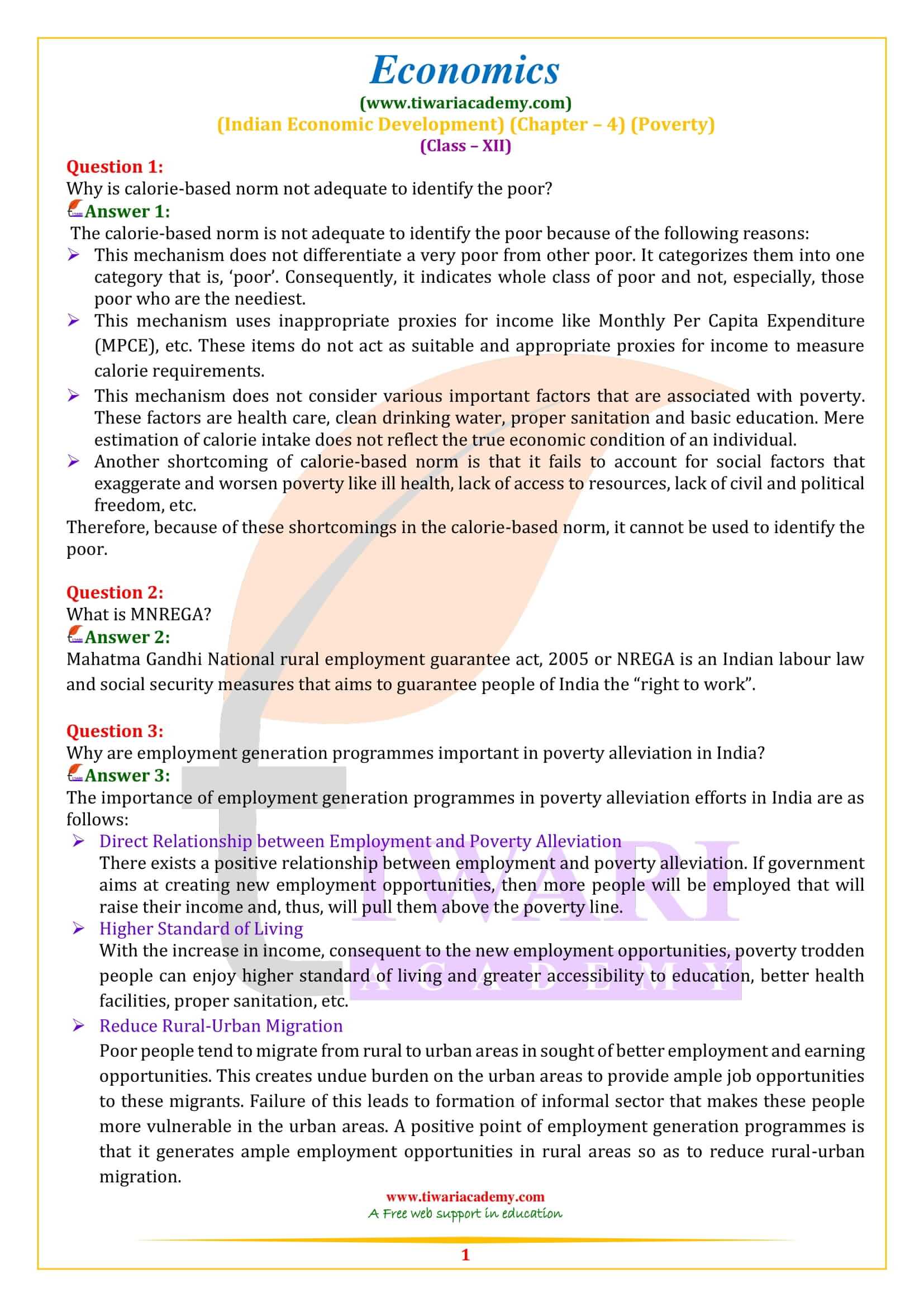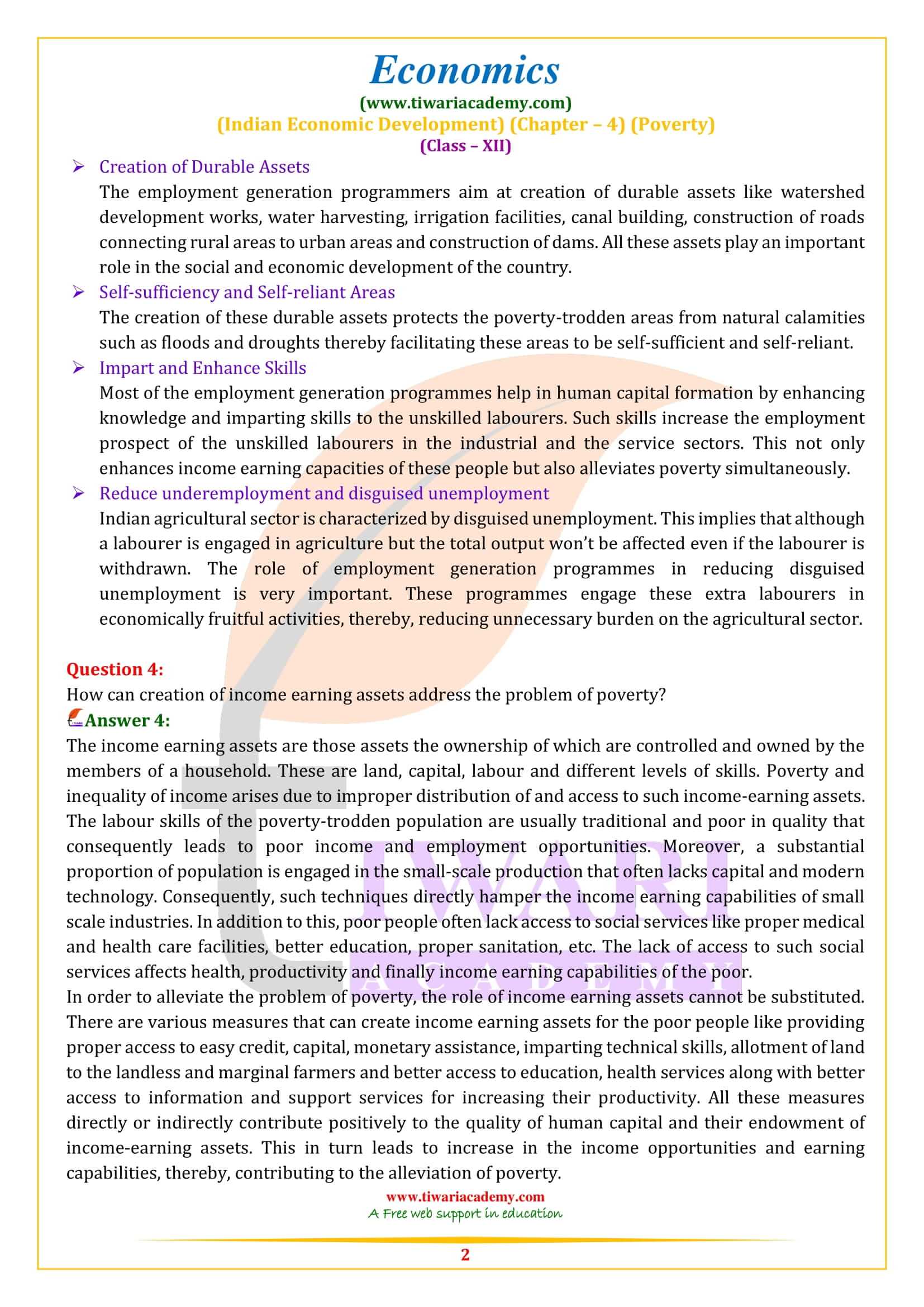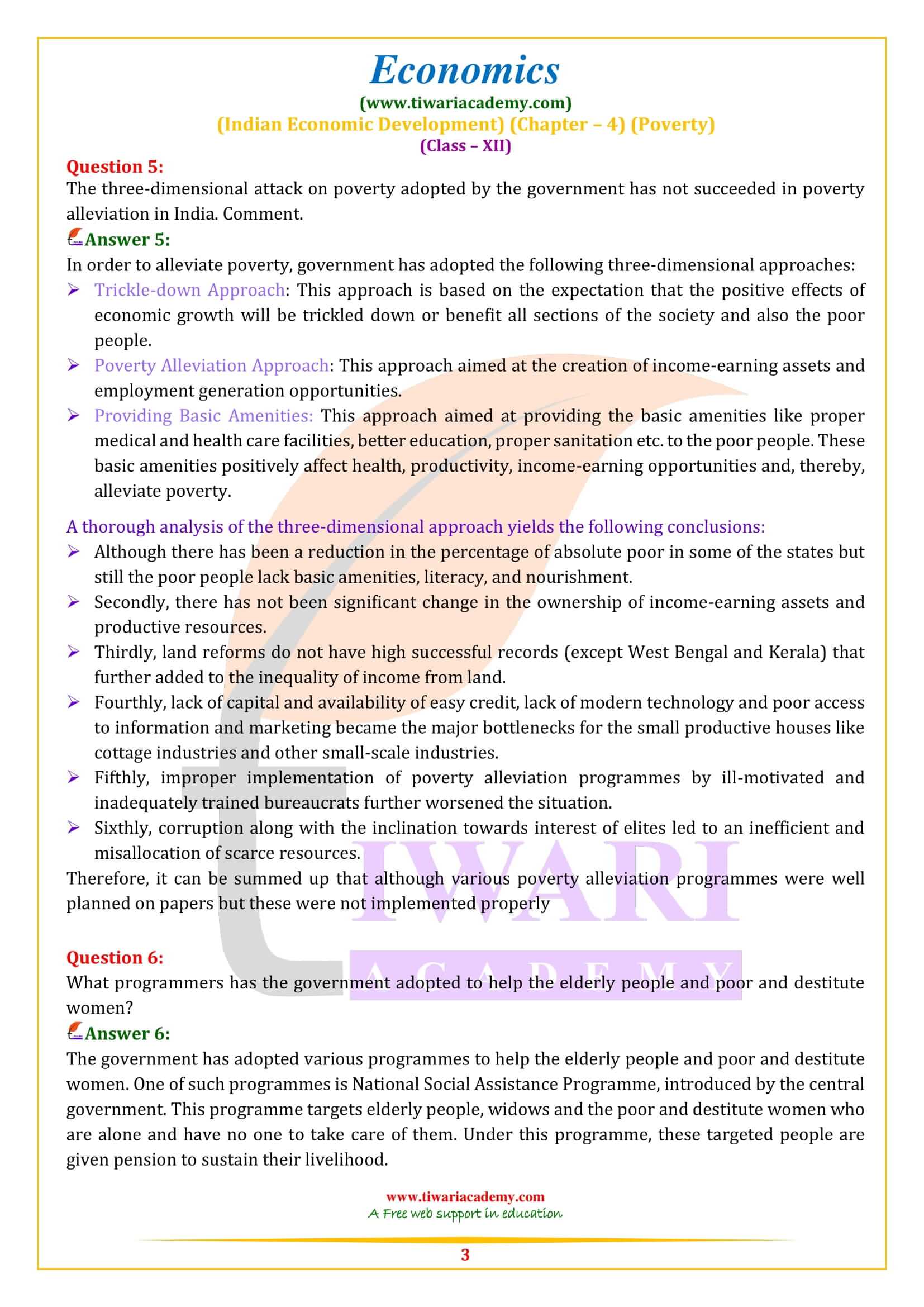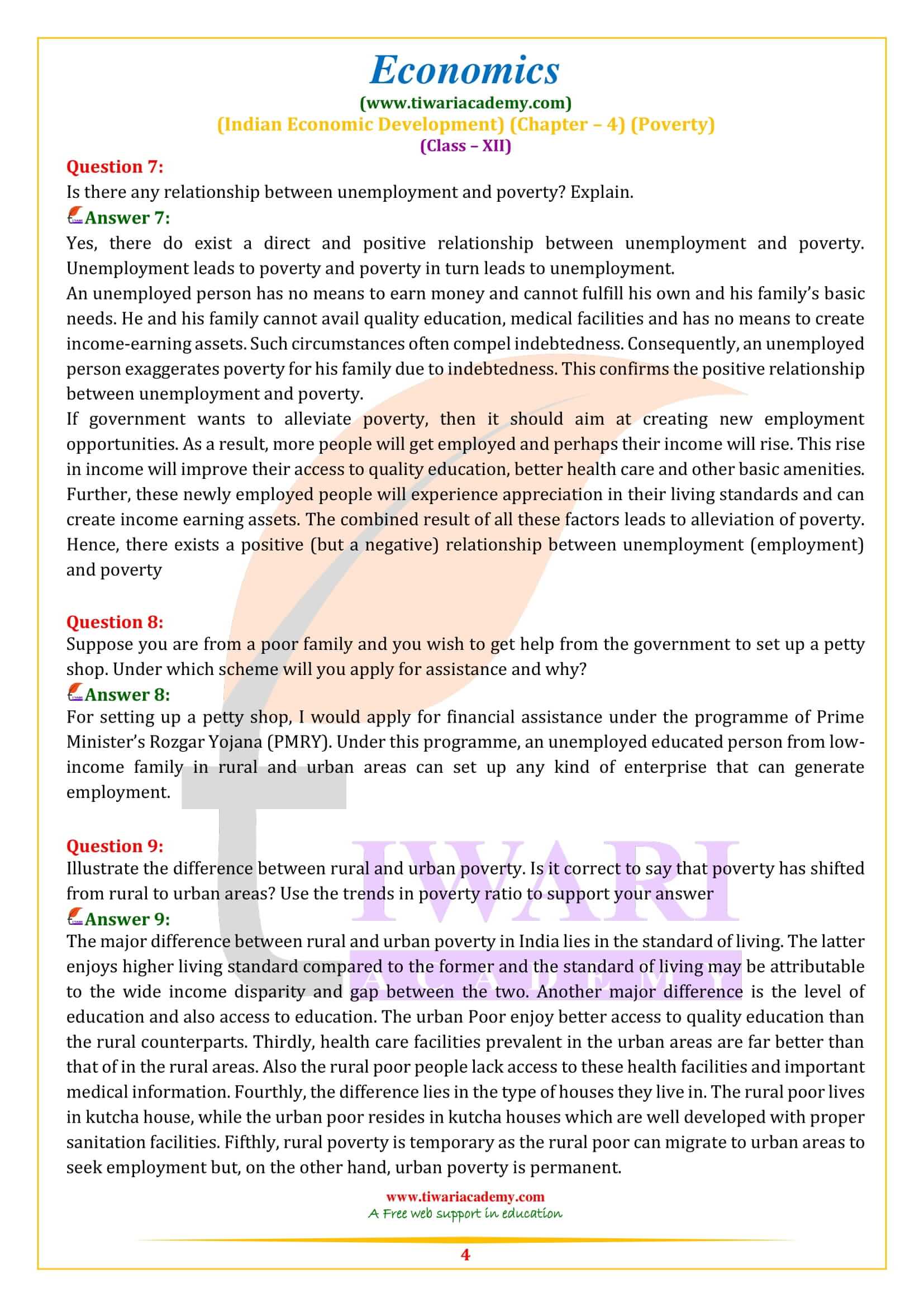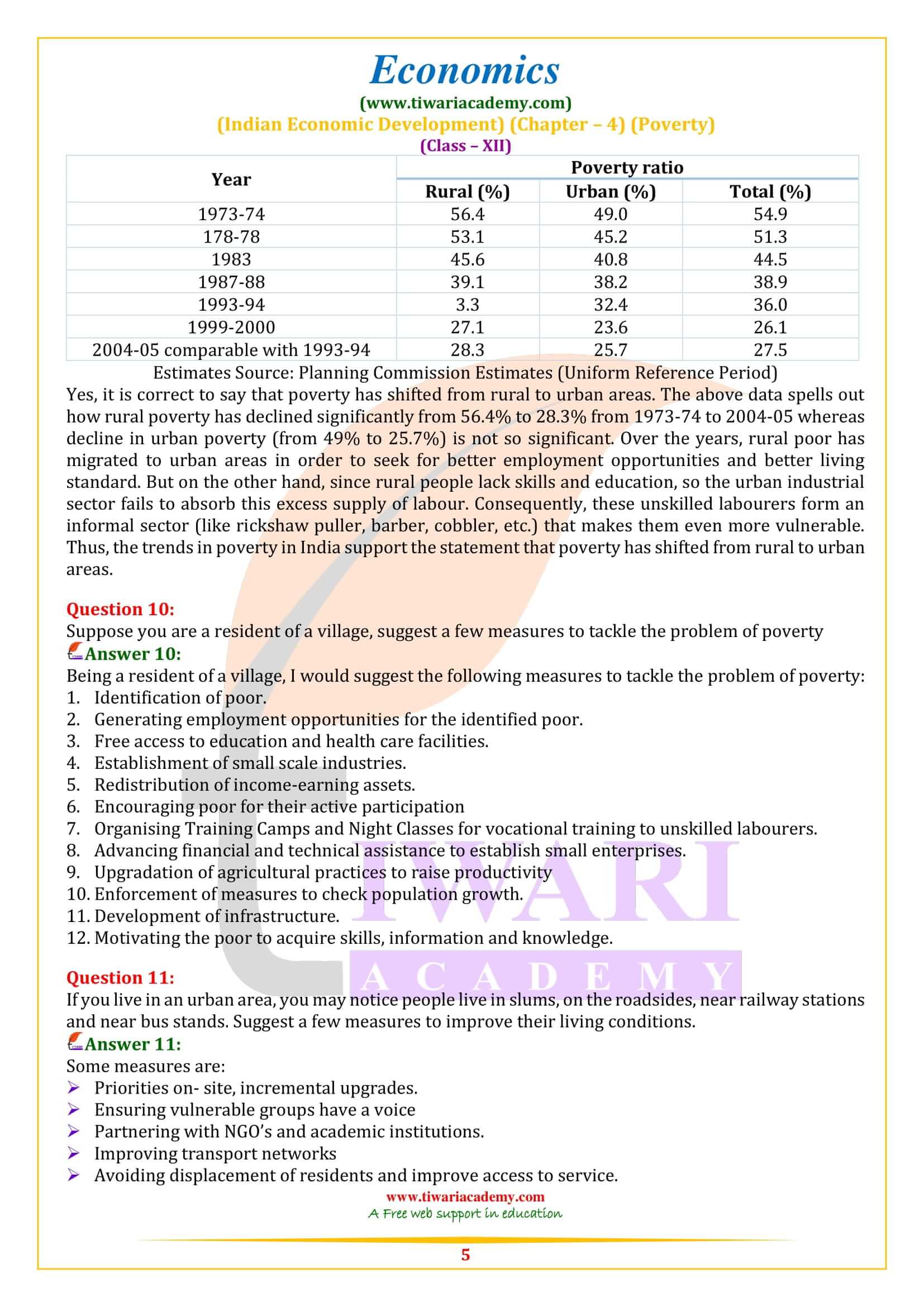NCERT Solutions for Class 12 Indian Economic Development Chapter 4 Poverty in Hindi and English Medium all question answers updated for new academic session 2024-25. Class 12 Economics chapter 4 solutions, MCQ and important extra questions are given in simplified manner.
Class 12 Indian Economic Development Chapter 4 Question Answers
Poverty – Who are the Poor?
You would have noticed that altogether localities and neighbourhoods, each in rural and concrete areas, there are a number of us who are poor and few of us who are rich. There also are people that belong to the numerous stages in between. Push-cart vendors, street cobblers, women who string flowers, rag pickers, vendors and beggars are some samples of poor and vulnerable teams in urban areas. The poor individuals possess few assets and reside in kutcha hutments with walls fabricated from baked mud and roofs fabricated from grass, thatch, bamboo and wood. The poorest of them don’t even have such dwellings. In rural areas several of them are landless. Although a number of them possess land, it’s solely dry or waste land. Several don’t get to own even two meals daily.
Starvation and Hunger in Poverty
Starvation and hunger are the key options of the poorest households. The poor lack basic acquisition and skills and thus have terribly restricted economic opportunities. Poor individuals conjointly face unstable employment. Deficiency disease is alarmingly high among the poor. Ill health, incapacity or serious ill health makes them physically weak. They borrow from moneylenders, who charge high rates of interest that lead them into chronic obligation.
The poor are extremely vulnerable. They are not capable to barter their legal wages from employers and are exploited. Most poor households don’t have any access to electricity. Their primary cookery fuel is firewood and cow dung cake. An outsized section of poor individuals doesn’t even have access to safe potable water. There’s proof of utmost gender difference within the participation of paying employment, education and in decision-making among the family. Poor ladies receive less care on their way to motherhood. Their children are less likely to survive or be born healthy.
Identification of Poverty Level
If India is to unravel the matter of impoverishment, it’s to seek out viable and sustainable methods to deal with the causes of impoverishment and style schemes to assist the poor out of their scenario. However, for these schemes to be enforced, the govt must be able to identify who the poor are. For this, there is need to develop a scale for poverty measurement. In pre-independent India, Dada Bhai Naoroji used the menu for a prisoner and used acceptable prevailing costs to arrive with what is also referred to as ‘jail price of living’. He thus, suitably adjusted this price of living to gain the poverty level.
In post-independent India, there are many tries to figure out a mechanism to spot the amount of poor within the country. As an example, in 1962, the Planning Commission, now called as NITI Aayog, formed a study group. In 1979, another body called ‘Task Force on Projections of Minimum Needs and Effective Consumption Demand’ was formed. In 1989 and 2005, ‘expert groups’ were accepted for an equivalent purpose. Besides the Planning Commission, many individual economists have also attempted to develop such a mechanism.
The aim of Process Impoverishment
For the aim of process impoverishment, we tend to divide individuals into two categories; the poor and therefore the non-poor and the poverty line separates the two. However, there are several forms of poor; the fully poor, the terribly poor and the poor. Similarly, there are numerous types of non-poor; the middle class, the upper middle class, the rich, the very rich and the absolutely rich. Think of this as a line or continuum from the terribly poor to the fully wealthy with the poverty line dividing the poor from the non-poor.
There are many ways to reason impoverishment. In one such manner people who are forever poor and those who are sometimes poor however but who could typically have a touch extra money is grouped together as the chronic poor. Another cluster are the churning poor who frequently move in and out of impoverishment and the occasionally poor who are rich most of the time but may sometimes have a patch of bad luck. They are called the transient poor. And then, there are those who are never poor and they are the non-poor.
What is the Poverty Line?
There are many ways of mensuration of economic condition. First technique is to work it out by the value of the minimum calorie intake that was calculable at 2,400 calories for a rural person and 2,100 calories for a person in the urban area. Based on this, in 2011-12, the poverty level was outlined for rural areas as consumption value ₹816 per person a month and for urban areas it absolutely was ₹1,000. Although the govt uses Monthly Per Capita Expenditure (MPCE) as proxy for financial gain of households to spot the poor, does one suppose this mechanism satisfactorily identifies the poor households in our country?
Poverty Economists state that a significant drawback with this mechanism is that it teams all the poor along and doesn’t differentiate between the terribly poor and therefore the different poor. Conjointly, this mechanism takes under consideration expenditure on food and a couple of select things as proxy for financial gain, economists question its basis. This mechanism is useful in characteristic the poor as a gaggle to be taken care of by the govt, however it might be troublesome to spot who among the poor want facilitate the foremost.
Factors related to Poverty
There are several factors, apart from financial gain and assets that are related to poverty; as an example, the accessibility to basic education, health care, drinking water and sanitation. They have to be thought of to develop Poverty Level. The prevailing mechanism for determination of the Poverty Level conjointly doesn’t take into thought social factors that trigger and bear on poverty like as illiteracy, ill health, lack of access to resources, discrimination or lack of civil and political freedoms.
The aim of poverty alleviation schemes ought to be to boost human lives by increasing the vary of things that an individual may be or will do, like to be healthy and nourished, to be knowledgeable and participate within the lifetime of a community. From this point of view, development is concerning removing the obstacles to the items that a person can do in life, like illiteracy, ill health, lack of access to resource es, or lack of civil and political freedoms.
Is it necessary to understand and learn the different poverty alleviation programmes of the Central Government in class 12 chapter 4 of Indian Economic development?
Yes, the important ones are PM Rojgar Yojana, Swarn Jayanti Shari Rojgar Yojana, Swarn Jayanti Gram Swarozgar Yojana, MGNREGP (Mahatma Gandhi National Rural Employment Guarantee programme.
What are the important concepts in the topic Poverty in class 12th Indian economy from Examination point of view?
The definition of poverty, the types of poverty, poverty line, causes of poverty and poverty alleviation programmes are important topics in class 12th in Indian economy from Examination point of view.
Is the causes of poverty, in economics, important for class 12th examination point of view?
Apart from economic reasons there are political reasons and population exposure which causes poverty. It is quite important for class 12 economics examination.
